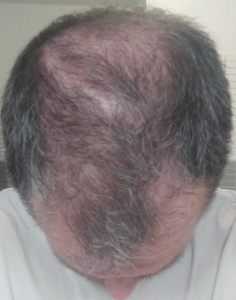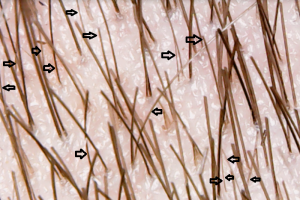Hello, Dr. Rassman, I have a couple questions for you about hairlines. You see, I’m a little confused…
I am a 24-year-old Caucasian male with no outward signs of pattern baldness, even though it does run on both sides of my family. I was looking at pictures of myself the other day from when I was about 12, and noticed in one picture of me with a crew cut, that I at one time had a very rounded hairline, like that of a female. This got me thinking (and a little worried), since my hairline today looks like that of the guy in the first picture on the Norwood scale. It’s not the hairline I had when I was 12, but it’s not a “mature hairline” either. I did the brow measurements and my hairline is still very much in the juvenile position, albeit more square in shape and rising slightly at the corners, just like the guy in the picture.
So I’m curious, is it possible for the first Norwood illustration to be the mature hairline in some cases? My hairline has been like this since I was about 18 or 19-years-old and hasn’t moved an inch since then.
Thank you for your help on the matter.
 I’d say that yes, a Norwood Class 1 (see art at right) and a mature hairline are basically the same. The hairline you saw at 12 years old is your childhood hairline and it is completely normal for your hairline to mature to some degree a dozen years later. You can not tell at your age for sure, but with a good mapping of your scalp and measurements looking for miniaturization in the corners, you might just see where your hair loss is going, if anywhere.
I’d say that yes, a Norwood Class 1 (see art at right) and a mature hairline are basically the same. The hairline you saw at 12 years old is your childhood hairline and it is completely normal for your hairline to mature to some degree a dozen years later. You can not tell at your age for sure, but with a good mapping of your scalp and measurements looking for miniaturization in the corners, you might just see where your hair loss is going, if anywhere.

 I’d say that yes, a Norwood Class 1 (see art at right) and a mature hairline are basically the same. The hairline you saw at 12 years old is your childhood hairline and it is completely normal for your hairline to mature to some degree a dozen years later. You can not tell at your age for sure, but with a good mapping of your scalp and measurements looking for
I’d say that yes, a Norwood Class 1 (see art at right) and a mature hairline are basically the same. The hairline you saw at 12 years old is your childhood hairline and it is completely normal for your hairline to mature to some degree a dozen years later. You can not tell at your age for sure, but with a good mapping of your scalp and measurements looking for 
